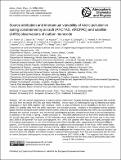| dc.contributor.author | Fisher, J. A. | |
| dc.contributor.author | Jacob, Daniel J. | |
| dc.contributor.author | Purdy, M. T. | |
| dc.contributor.author | Kopacz, M. | |
| dc.contributor.author | Le Sager, P | |
| dc.contributor.author | Carouge, C. | |
| dc.contributor.author | Holmes, C. D. | |
| dc.contributor.author | Yantosca, Robert M. | |
| dc.contributor.author | Batchelor, R. L. | |
| dc.contributor.author | Strong, K. | |
| dc.contributor.author | Diskin, G. S. | |
| dc.contributor.author | Fuelberg, H. E. | |
| dc.contributor.author | Holloway, J. S. | |
| dc.contributor.author | Hyer, E. J. | |
| dc.contributor.author | McMillan, W. W. | |
| dc.contributor.author | Warner, J. | |
| dc.contributor.author | Streets, D. G. | |
| dc.contributor.author | Zhang, Q. | |
| dc.contributor.author | Wang, Y. | |
| dc.contributor.author | Wu, S. | |
| dc.date.accessioned | 2014-03-17T20:14:41Z | |
| dc.date.issued | 2010 | |
| dc.identifier.citation | Fisher, J. A., Daniel J. Jacob, M. T. Purdy, M. Kopacz, P. Le Sager, C. Carouge, C. D. Holmes, et al. 2010. “Source Attribution and Interannual Variability of Arctic Pollution in Spring Constrained by Aircraft (ARCTAS, ARCPAC) and Satellite (AIRS) Observations of Carbon Monoxide.” Atmospheric Chemistry and Physics 10 (3) (February 1): 977–996. doi:10.5194/acp-10-977-2010. http://dx.doi.org/10.5194/acp-10-977-2010. | en_US |
| dc.identifier.issn | 1680-7316 | en_US |
| dc.identifier.issn | 1680-7324 | en_US |
| dc.identifier.uri | http://nrs.harvard.edu/urn-3:HUL.InstRepos:11930181 | |
| dc.description.abstract | We use aircraft observations of carbon monoxide (CO) from the NASA ARCTAS and NOAA ARCPAC campaigns in April 2008 together with multiyear (2003–2008) CO satellite data from the AIRS instrument and a global chemical transport model (GEOS-Chem) to better understand the sources, transport, and interannual variability of pollution in the Arctic in spring. Model simulation of the aircraft data gives best estimates of CO emissions in April 2008 of \(26 Tg month^{−1}\) for Asian anthropogenic, 9.4 for European anthropogenic, 4.1 for North American anthropogenic, 15 for Russian biomass burning (anomalously large that year), and 23 for Southeast Asian biomass burning. We find that Asian anthropogenic emissions are the dominant source of Arctic CO pollution everywhere except in surface air where European anthropogenic emissions are of similar importance. Russian biomass burning makes little contribution to mean CO (reflecting the long CO lifetime) but makes a large contribution to CO variability in the form of combustion plumes. Analysis of two pollution events sampled by the aircraft demonstrates that AIRS can successfully observe pollution transport to the Arctic in the mid-troposphere. The 2003–2008 record of CO from AIRS shows that interannual variability averaged over the Arctic cap is very small. AIRS CO columns over Alaska are highly correlated with the Ocean Niño Index, suggesting a link between El Niño and Asian pollution transport to the Arctic. AIRS shows lower-than-average CO columns over Alaska during April 2008, despite the Russian fires, due to a weakened Aleutian Low hindering transport from Asia and associated with the moderate 2007–2008 La Niña. This suggests that Asian pollution influence over the Arctic may be particularly large under strong El Niño conditions. | en_US |
| dc.description.sponsorship | Engineering and Applied Sciences | en_US |
| dc.language.iso | en_US | en_US |
| dc.publisher | European Geosciences Union | en_US |
| dc.relation.isversionof | doi:10.5194/acp-10-977-2010 | en_US |
| dash.license | LAA | |
| dc.title | Source Attribution and Interannual Variability of Arctic Pollution in Spring Constrained by Aircraft (ARCTAS, ARCPAC) and Satellite (AIRS) Observations of Carbon Monoxide | en_US |
| dc.type | Journal Article | en_US |
| dc.description.version | Version of Record | en_US |
| dc.relation.journal | Atmospheric Chemistry and Physics | en_US |
| dash.depositing.author | Jacob, Daniel J. | |
| dc.date.available | 2014-03-17T20:14:41Z | |
| dc.identifier.doi | 10.5194/acp-10-977-2010 | * |
| dash.authorsordered | false | |
| dash.contributor.affiliated | Yantosca, Robert | |
| dash.contributor.affiliated | Le Sager, P | |
| dash.contributor.affiliated | Jacob, Daniel | |


